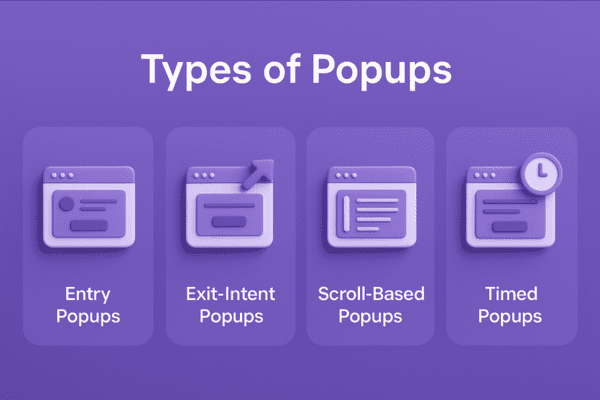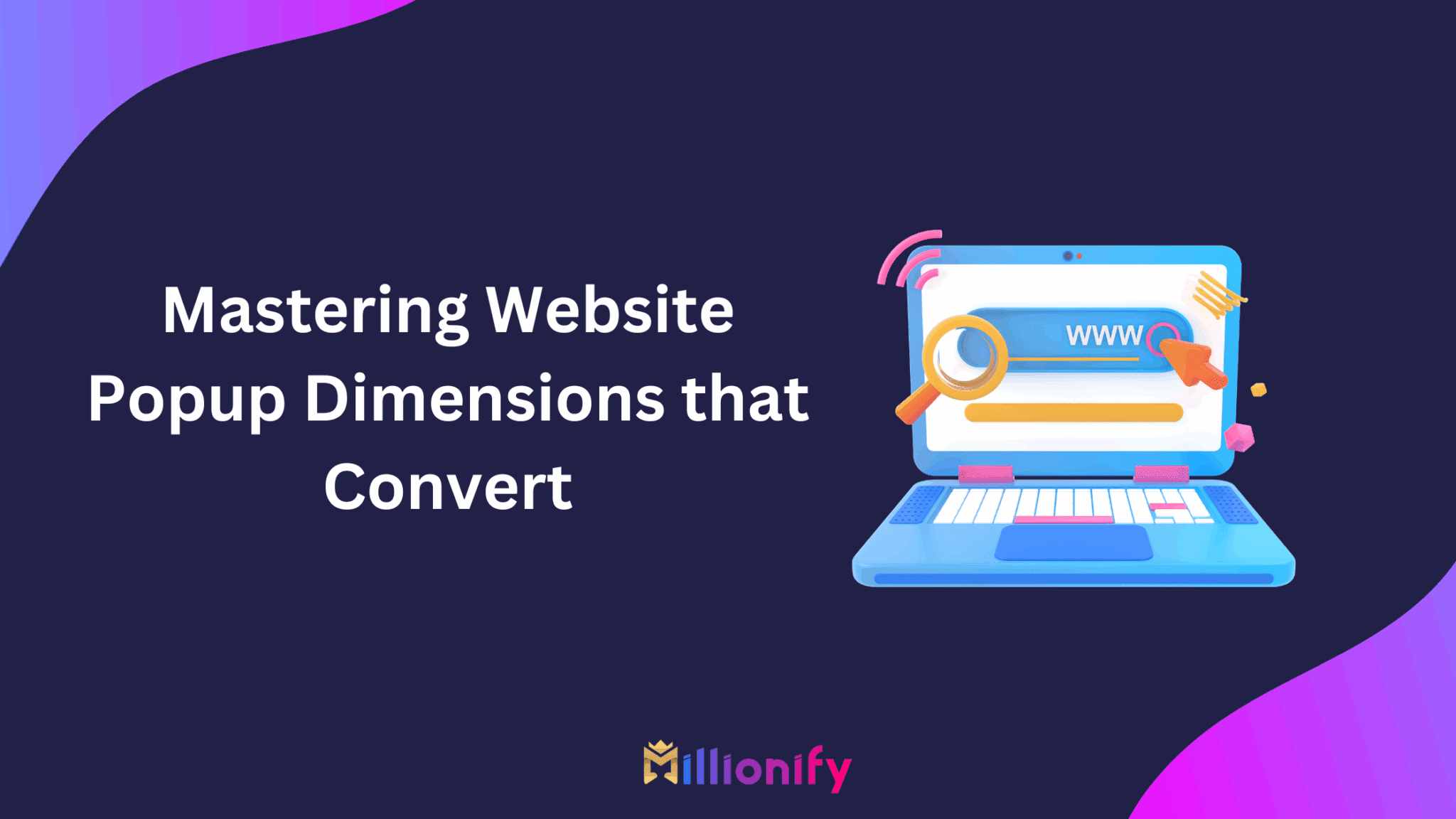Hey there, future Millionaires of the digital world! At Millionify, we’re all about helping you capture attention, convert visitors, and make your online presence shine. Today, we’re diving into a tool that, when used wisely, can supercharge your website’s performance: popups!
Yes, you heard that right – popups! Often misunderstood, but incredibly powerful when done right. Let’s explore how the perfect popup type, size, and design can transform your user engagement, boost conversions, and even play nice with your SEO. Ready to turn those fleeting visits into lasting connections? Let’s go!
What Are Popups?
At their core, popups are simply overlay elements that appear on your website, designed to grab a user’s attention at a specific moment. They’re like a friendly nudge or a spotlight, directing your visitor’s focus to something important.
Think of them as your website’s personal assistant, ready to:
- Make an announcement: “New product launch!”
- Grow your email list: “Join our newsletter for exclusive tips!”
- Offer a special deal: “Get 15% off your first purchase!”
- Guide an action: “Download our free guide!”
When strategically deployed, popups are powerful tools for driving specific user actions and enhancing their journey on your site.
Common Types of Popups
Not all popups are created equal, and knowing the different types is key to choosing the right one for your Millionify strategy. Each type has its unique trigger and best use case:

| Popup Type | Trigger | Best Use Cases |
|---|---|---|
| Entry Popups | Appear immediately when a user lands on a page. | Announcing site-wide sales, age verification, cookie consents. Use sparingly, as they can be intrusive. |
| Exit-Intent Popups | Trigger when the user’s mouse indicates they’re about to leave the site (or back button is pressed on mobile). | Recapturing abandoning visitors with a last-minute offer, discount, or compelling lead magnet. |
| Scroll-Based Popups | Display after a user scrolls a certain percentage of the page (e.g., 50%). | Offering related content, signing up for a newsletter after consuming some content, suggesting next steps. |
| Timed Popups | Show after a predefined delay (e.g., 10 seconds). | Gentle prompts for newsletter sign-ups, special offers, or feedback requests once a user has engaged a bit. |
| Click-Activated Popups | Open when a user clicks on a button, link, or image. | Ideal for content upgrades, detailed forms, product quick views, or sign-up forms that don’t interrupt browsing. |
How to Choose the Right Popup Size
Choosing the right size isn’t just about aesthetics; it’s about functionality and user experience. Here’s how to think about it for your Millionify campaigns:
- Consider Your Content:
- Text-heavy? You’ll need more vertical space to ensure readability without endless scrolling.
- Visuals, images, or videos? Wider popups might be better to showcase your stunning graphics.
- Forms with multiple fields? Plan for enough height to accommodate all input fields comfortably. Don’t make users feel cramped!
- Match with Position:
- Center Overlay: These usually require larger dimensions to make a statement and ensure visibility. They pause the user’s interaction with the main content.
- Corner Slide-in: Smaller, more discreet, these popups “slide in” from a corner and are less intrusive. They’re great for gentle reminders or quick announcements.
- Sticky Bar: These are fixed at the top or bottom of the screen and span full width, needing minimal height. Perfect for urgent messages or ongoing promotions.
- Balance Visibility and Usability: This is the golden rule! Your popup needs to be visible enough to be effective, but not so large that it covers the entire screen, frustrates users, or makes it impossible to find the close button. Think of it as a helpful billboard, not a roadblock. A good popup should enhance the experience, not disrupt it.
Recommended Popup Dimensions
While customization is key, here are some Millionify-approved general guidelines for popup dimensions to get you started:
A. For Desktop
Desktop users generally have more screen real estate, allowing for larger, more impactful popups.
| Popup Type | Width Range (px) | Height Range (px) | Notes |
|---|---|---|---|
| Full-Screen Overlay | 800–1200 | 600–900 | Best for critical announcements, lead magnet forms, or highly visual promotions. |
| Slide-in Popup | 300–500 | 300–600 | Ideal for non-intrusive newsletter sign-ups, related content suggestions, or chat prompts. |
| Sticky Bar | Full width | 30–60 | Excellent for time-sensitive offers, shipping announcements, or ongoing promotions. |
B. For Mobile
Mobile screens are precious! Your popups need to be compact, clear, and perfectly responsive to avoid penalization from search engines and frustration for users.
| Popup Type | Width Range (px) | Height Range (px) | Notes |
|---|---|---|---|
| Full-Screen Popup | 320–480 | 480–800 | Often used for essential notices like age gates or cookie consents. Ensure easy closing. |
| Slide-in Popup | 250–350 | 250–400 | Great for subtle nudges without covering the main content. |
| Sticky Bar | Full width | 30–50 | Similar to desktop, but slightly shorter to save screen space. |
SEO Optimization Tips for Popups
You might wonder, “Do popups affect my Google ranking?” Yes, they can! But with the right strategy, you can make them SEO-friendly for Millionify success.
- Use Keyword-Rich and Relevant Content: While popups aren’t direct SEO powerhouses, the content within them still matters. Ensure any text within your popup is clear, concise, and relevant to the page content and your offer. If it includes keywords, even better, but avoid keyword stuffing.
- Make Sure Popups Are Responsive and Mobile-Friendly: Google loves mobile-friendly websites. If your popups aren’t responsive, they can hinder user experience on mobile, leading to higher bounce rates and potentially lower search rankings. Always test them on various devices!
- Avoid Intrusive Interstitials: This is crucial! Google specifically targets “intrusive interstitials” – those full-screen popups that block content, especially on mobile, when a user first lands on a page. Use entry popups with extreme caution. Prioritize non-intrusive options like exit-intent or scroll-based for mobile if your goal is SEO.
- Compress Images and Limit Scripts: Page load speed is a significant SEO factor. Heavy images or excessive scripts in your popups can slow down your site. Optimize all media files (compress, use modern formats like WebP) and ensure your popup builder uses efficient code.
- Provide Clear Navigation (e.g., Easy-to-Find Close Buttons): If users can’t easily close your popup, it’s a frustrating experience that can lead to them leaving your site entirely. Google’s algorithms notice user behavior. Always include a prominent ‘X’ button or allow clicking outside the popup to close it.
Best Practices for Using Popups
Now that we know the technicalities, let’s talk strategy. Here are Millionify’s best practices for making your popups effective and user-friendly:
- Avoid Using Popups Excessively or At Annoying Times: Less is often more! Don’t bombard your visitors with popups on every page, or immediately upon arrival unless absolutely necessary (like an age gate). Think about the user journey: when would this message be most helpful or least disruptive?
- Keep the Message Short, Clear, and Valuable: Attention spans are fleeting. Your popup’s message should be a quick read, immediately conveying your offer or call to action. Highlight the benefit to the user – what’s in it for them?
- Make the Popup Visually Appealing and Easy to Close: A beautiful, on-brand popup is more likely to engage. Use clear fonts, appealing colors, and high-quality images. And as mentioned, ensure that close button is unmistakable!
- Personalize Messaging Based on User Behavior or Demographics: This is where popups become truly powerful! Imagine a popup offering a discount on products a user just viewed, or a guide relevant to a blog post they’re reading. Personalization drastically increases conversion rates.
- Track Engagement and Test Different Formats Regularly: Don’t set and forget! Use your analytics to see how your popups are performing. Are people signing up? Are they closing it immediately? A/B test different headlines, images, offers, timings, and sizes to continuously optimize for Millionify-level results.
Conclusion
Popups, when designed with intention and implemented with care, are far from annoying. They are, in fact, incredibly powerful tools for accelerating conversions and deepening user engagement on your website.
At Millionify, we believe the right popup type, size, and responsiveness aren’t just details – they’re game-changers that can significantly impact your bottom line. By prioritizing user experience, optimizing for speed, and continuously testing, you’ll ensure your popups enhance, rather than disrupt, the valuable journey your visitors take on your site.
Frequently Asked Questions (FAQs)
Q: Are popups bad for my website’s SEO?
Not necessarily! While intrusive popups (especially on mobile) can negatively impact SEO, well-designed, responsive, and non-intrusive popups that enhance user experience can actually support your SEO efforts by boosting engagement and conversions.
Q: What’s the best type of popup for capturing email leads?
Exit-intent popups are often highly effective for email capture, as they offer a last chance to engage users who are about to leave. Scroll-based and timed popups can also work well once a user has shown some interest in your content.
Q: How can I make sure my popups are mobile-friendly?
Ensure your popup builder offers responsive design options. Test your popups rigorously on various mobile devices to confirm they scale correctly, don’t cover essential content, and have easily clickable close buttons.
Q: Should I use full-screen popups on my site?
Use full-screen popups sparingly, especially on entry. While they can be impactful for critical notices, they are often considered intrusive by Google and users. Consider alternatives like slide-ins or sticky bars for less disruptive engagement.
Q: How often should I change or test my popups?
Regular A/B testing is crucial! Continuously test different designs, messages, timings, and offers. There’s no fixed schedule, but monitoring conversion rates and user feedback will tell you when it’s time to optimize or try something new.



